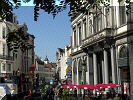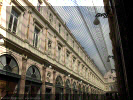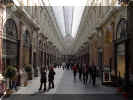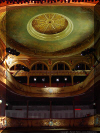In 1836, the young architect Jean-Pierre Cluysenaer, born in the Netherlands in 1811, had
the idea to construct a covered gallery of more than 200 meters that would
directly link the "Marché aux
Herbes" (herbs market) to the "Montagne aux Herbes
Potagères" (vegetables market), by
demolishing a number of sordid alleys in which the bourgeoisie did not dare
to come. On the 22nd of February 1845, the City
Council, presided by Burgomaster Wyns de Raucourt, found a large majority in favor
of the project. On the 3rd of April, a royal decree allowed the works to
begin, three months before the "Société des Galeries Saint-Hubert"
(the Company of the Saint-Hubert Galleries) was founded. The conceiver of the
project and the bank manager Jean-André De Mot, who was the father of
Emile De Mot (the future burgomaster of Brussels), were members of the company.
When the construction was already in an advanced phase, the first stone was laid with
a golden trowel by King Leopold the First, accompanied by his two sons. At
the meeting of the board of the company on the 4th of December 1846, the
names of the three parts of the new gallery, to pay homage to the royal family, were agreed
upon :
the
Galerie du Roi
(the
King's gallery) to the east of the Rue des Bouchers,
the
Galerie de la Reine
(the
Queen's gallery) to the west, and the Galerie du Prince
(the prince's gallery), a 54 meter
long gallery that links the Galerie du Roi
to the
Rue des
Dominicains. In October 1965, the building, originally called
"Passage Saint-Hubert", received its present name "Galeries
Royales Saint-Hubert". This collective name comes from the old Rue Saint-Hubert that linked the Rue du Marché aux Herbes to the Rue des Bouchers. This narrow street already existed in the 13th century, but it was called "Bogart" or "Bomgaard" (orchard street). It has also been called "Spiegelstreetken" (Mirror alley). The name of Saint-Hubert appears in 1685 (St Huybrechtsstraet), because of a cabaret dedicated to this Saint. The cabaret was very often visited by the "échoppiers" (stall keepers) of the nearby Marché aux Herbes. During the French regime, it was called "Rue du Chasseur" (hunter street).
During the years, the Passage Saint-Hubert became a literary centre, where one could meet famous French writers such as Baudelaire, Alexandre Dumas, Victor Hugo, Apollinaire or Verlaine in the "Café de la Renaissance" (the present "Taverne du Passage"), which was the meeting place of the Artistic et Literary Circle. Nowadays, the galleries still are an important commercial centre for luxury goods in an old-fashioned environment that was recently restored with a lot of care. Among the remarkable shops, there is the number 23 of the Galerie de la
Reine, where the Swiss Jean Neuhaus installed a confectioner's shop in 1857. Neuhaus
was specialized in making cough bonbons, marshmallows and liquorices for stomach pain. His
son Frédéric made delicacies such as chocolates filled with vanilla. In 1912,
Jean Neuhaus introduced a number of novelties, such as chocolates filled with
fruits, crushed nuts paste, various sorts of creams and even liquors. He
called them "pralines", because their form looked like the grilled nuts covered with sugar of the Marquis
of Praslin. One fine day, his
wife came up with the idea of putting the pralines carefully in a little cardboard
box, because she was tired of serving them in a paper wrapper. They called
this cardboard box a "ballotin". Since the beginning of the previous century, number 31 has housed the renowned
Belgian leather shop Delvaux, creator and manufacturer of the most refined traveling-bags,
trunks, handkerchiefs, purses, and various leather objects.
Cultural life was present in the galleries as well. In the Galerie du Roi number
32, one can still find the Theatre of Saint-Hubert Galleries, that was
conceived by Jean-Pierre Cluysenaer himself and inaugurated on the 7th of
June 1847. Originally it was used for comedy, drama and vaudeville. In
fact, the City Council of Brussels had forbidden singing or music, in
order to prevent it from competing with the "Théâtre Royal de la
Monnaie". The first spectacle that was organized in the new hall was a "phantasmagoria",
followed by a revue. In 1849, it changed its name to the third "Theatre
Royal" of Brussels, after the Theatre Royal de la Monnaie and the Theatre
Royal du Parc. From 1860 onwards, the theatre was allowed to
stage operettas and revues with orchestra. Thus began a long era of
revues, with or without music, that were enormously popular with the
Brussels audience. In 1951, the hall was completely demolished as it had become too old and no longer complied with the new standards of security. A new and larger hall was built in no time, with two broad balconies in the middle, instead of the previous four narrow peripheral galleries. The Theatre Royal des Galeries still has an enormous success, and its famous "Revue" keeps attracting a large audience. The Vaudeville was recently restored and is now used again as theatre and reception room. |





